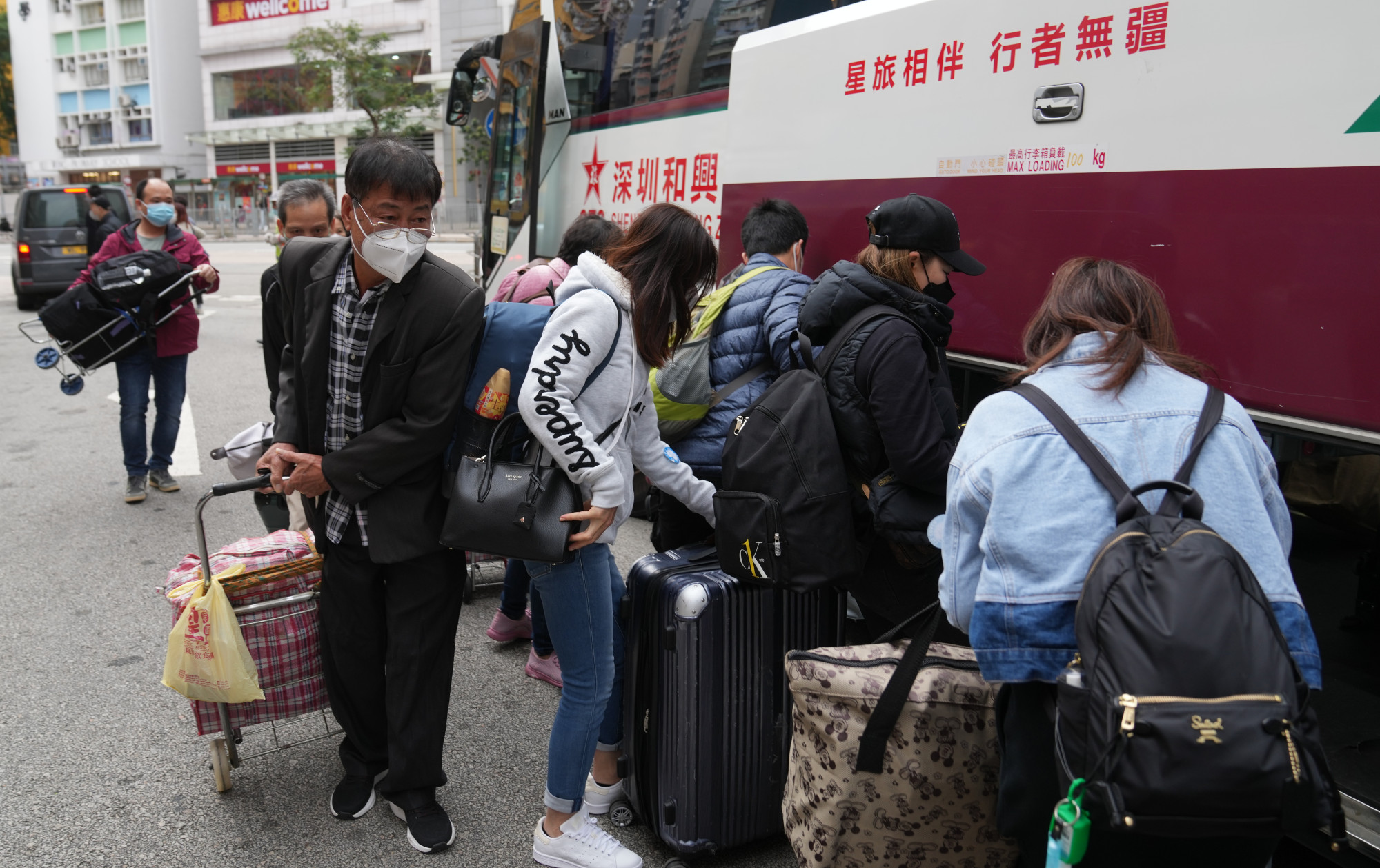
Coronavirus: 23,500 cross into Hong Kong from mainland China via land in past 2 days, while 52,200 head north
- Local pharmacies and tour bus operators disappointed over number of mainland arrivals after daily quota of 50,000 in either direction takes effect
- But lawmaker Peter Shiu says mainland authorities might have considered Hong Kong’s limited transport when approving new travel permits
Local pharmacies and tour bus operators expressed disappointment on Monday over the number of mainland arrivals, while a lawmaker said authorities across the border might have taken the city’s limited transport capacity into account when approving visas for travel.
Excluding traffic at the airport and ferry terminals, 23,522 people entered Hong Kong over the past two days, just 45 per cent of the 52,229 who headed to the mainland, according to the Immigration Department.
Department figures for air and sea routes do not distinguish arrivals from the mainland and Macau from other places.
The daily quota for crossings is set at 50,000 people in either direction, while another 10,000 are expected to use the airport and ferries, again going both ways.
All but one of the seven available checkpoints, the airport, had seen the number of outbound passengers significantly exceeding the figure for inbound ones.
About 3,800 people crossed into Hong Kong at the Lok Ma Chau railway station on Monday, only half of the 8,678 people who left using the same route
The second most popular crossing was at Shenzhen Bay. Despite a daily quota of 10,000 each way at that crossing, only 2,000 headed south and 4,400 north.
The Man Kam To checkpoint, located to the east of Lo Wu, was only lightly used, recording just 288 southbound travellers and 338 northbound ones.
Major Hong Kong business group predicts 2023 turnaround, 3.8 per cent growth
On the mainland side, online bookings to cross between Tuesday and this Sunday amounted to 10,510 at Shenzhen Bay and 14,888 at Futian. The two border crossings allow up to 10,000 and 35,000 mainland residents respectively to pass through each day.
Some pharmacies in Hong Kong said they had yet to enjoy any boom in demand despite having stocked up in anticipation of mainland visitors seeking medicine to treat Covid-19 symptoms.
“Sales in the first two days were more or less the same as before,” said a manager of one shop in Sheung Shui close to the border. “Yet now we face a new fear as our landlord just told us that he might increase the rent due to the policy change.”
Phoebe Wang, chief operating officer of Sinoway (China), which operates a shuttle between Sheung Shui and Man Kam To, said she was disappointed over the low number of arrivals from the mainland.
She suspected some might have only applied to renew their travel documents after last month’s reopening announcement, so it could take time for them to get their permits back and plan their Hong Kong trips.
Lawmaker Peter Shiu Ka-fai, representing the wholesale and retail sector, said mainland authorities might have taken Hong Kong’s transport capacity into consideration when approving new travel permits.
“A gradual approach is understandable and necessary to minimise risks on Hong Kong’s healthcare system and prevent conflict with people across the border,” he said.
On Monday, Hong Kong logged 11,641 new Covid-19 infections, including 323 imported ones. Sixty-four patients infected with the virus died.
Under the reopening scheme, travellers must show immigration officers a negative polymerase chain reaction (PCR) test result taken within 48 hours of departure.
Timothy Chui Ting-pong, executive director of the Hong Kong Tourism Association, said he was not surprised by the inbound figures.

Some mainlanders’ plans to visit Hong Kong could have been affected by the ongoing Covid-19 outbreak at home or the limited choice of transport south out of Shenzhen, he said.
“It’s not easy to get train or bus tickets to Shenzhen before they use the land crossings to enter Hong Kong ahead of Lunar New Year, which is a peak of time to travel on the mainland,” he said, referring to the holiday that begins on January 22.
Chui added he was not disappointed by the limited numbers as the sector still needed time to rehire guides and tour buses.
On Monday, Bernard Chan Pak-li, acting secretary for commerce and economic development, dismissed concerns over the limited economic benefit of the initial stage of the reopening, emphasising the importance of having a “gradual, healthy and steady” resumption of business.
Vendors lament low turnout at first Hong Kong trade showcase after border reopens
Secretary for Transport and Logistics Lam Sai-hung on Monday said rail giant the MTR Corporation had increased the frequency of trains on the East Rail line to 135 per day, while there were 90 daily departures before the pandemic.
Lam said he believed the current frequency would be able to handle the demand from local commuters and cross-border travellers, adding that there was spare capacity.
The minister also inspected the West Kowloon terminus of the cross-border express rail link, which had started trial runs. Officials earlier said the rail link would resume operation on January 15 at the latest.
Arriving in Hong Kong via the Futian checkpoint in Shenzhen at around 8.15am, Keith Yu, an IT worker at Huawei’s Hong Kong office, said he had been working remotely on the mainland before the border reopened.
“Today is the first time for me to work in person during the past year and I’m very excited now,” Yu said. “I haven’t seen many of my colleagues yet.”
“But it also means I will have to spend more time commuting to work,” he noted, adding it took him about 25 minutes to cross the border.
Additional reporting by Karin Lyu, Sammy Heung and Kang Chung Ng


